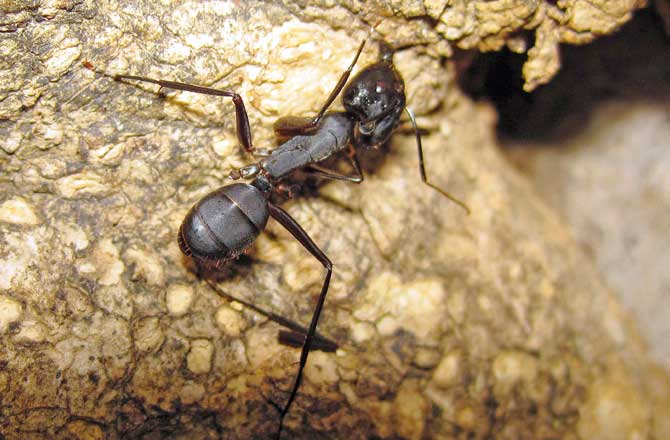People my age grew up reading epic children's series, viz. The Hardy Boys, Nancy Drew or the Famous Five. In every book, the characters would take basketsful of food to a meadow, to enjoy picnics

The Carpenter ant
 People my age grew up reading epic children's series, viz. The Hardy Boys, Nancy Drew or the Famous Five. In every book, the characters would take basketsful of food to a meadow, to enjoy picnics.
People my age grew up reading epic children's series, viz. The Hardy Boys, Nancy Drew or the Famous Five. In every book, the characters would take basketsful of food to a meadow, to enjoy picnics.
However, during my Class 3 picnic to Vihar Lake in Powai, red ants raided my bag of goodies. I wasn't willing to forfeit my favourite eats to the ants and made futile efforts to dust them off my tiffin. But those pesky and persistent creatures weren't ready to share their treasure with me. Resultantly, I realised that fiction was different from reality, at least in matters concerning ants.
ADVERTISEMENT
Attempt dropping a crumb of cupcake to the ground, and watch that turn into an unequivocal party invitation to the nearest colony of ants. Depending on your location in Mumbai and your distance from a forest, garden or the floor you live on, you may find between three to thirty varieties of ants.
This isn't surprising because ants form 15 per cent to 25 per cent of all terrestrial animal biomass. In the history of life on Earth, ants have outnumbered all other creatures that ever existed and currently there exist over million ants for every human!
The 12,500-odd known species of ants have colonised every landmass — continents or oceanic islands — except some parts of frozen Antarctica. Their success and proliferation is attributed to their ability to form complex hierarchical societies and construct elaborate residential complexes (nests) by modifying habitat, compounded by their capacity to horde resources and fend off attacks from predators far larger than individual ants.
The Carpenter ant
All ant colonies are lead by a Queen who breeds with a few drones (males). The other worker, nurse and soldier ants are either females or neuters. Queens enjoy lifespans of over 30 years — 100 times longer than any another insect its size. They communicate with each other using chemical signals (pheromones) and touching their antennae.
The extreme capabilities of ants aren't limited to longevity but extend to physical capacity of work. Asian Weaver ants (Oecophylla sps) are weight lifters among ants, carrying prey and leaf parts 100 times their own body weight. But the unique characteristic of an ant colony is that millions of ants function together as a single 'superorganism'.
Due to meticulous division of labour, social roles (castes) of every individual ant are pre-designated. Younger worker ants form the 'social stomach' and feed the entire colony — Queens, larvae, workers and drones. Older worker ants are sent out to forage for food and handle the defense of the colony, thus facing the highest risk of mortality. Although seemingly morbid, this seems most logical to me. Yet, humans have very closely shadowed ants to emulate their social orders.
Ants are intriguing since most varieties are harmless and misunderstood among average urbanites. Outdoing the earthworms, they are the planet's biggest recyclers and soil turners. Our homely Black ants are saprophytic — feeding largely on dead or decaying food matter.
Some varieties, like the red Fire ants that nest in wet walls of homes and flooded playgrounds are aggressive, bite humans and invade our food. The Pagoda ants (Crematogaster sps) are carnivorous while Harvester (Aphaenogaster sps) and Carpenter (Camponotus sps) ants are seed, wood and mushroom feeders. Besides being one of nature's most important creations, ants are the primary food for hundreds of invertebrates and vertebrates and some human cultures use ants in food or medication, and even worship them.
I hope today onwards, you will debate whether to revere ants for their selfless superorganism-like behaviour or terminate them for being invasive. Whatever your decision, take out time to watch these dinosaur-age insects meet, greet, share and joke via chemical messages, all the while quietly competing with humans to remain the Earth's aristocratic party goers.
 Subscribe today by clicking the link and stay updated with the latest news!" Click here!
Subscribe today by clicking the link and stay updated with the latest news!" Click here!







